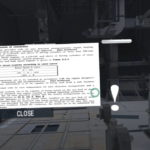Classification society Korean Register (KR) has developed a Virtual Reality training simulator, based on the linkage and utilization technology of the 3D ship model, developed through R&D cooperation with Korea’s leading shipyards and shipping companies
In recent years, maritime industry has introduced the concept of a digital twin to maximize operational efficiencies by combining the[ds_preview] data generated during the ship’s life cycle with the ship’s 3D digital model. This concept currently supports a seamless workflow and reduces production costs at the ship production stage, and in the future it will also be possible to evaluate the customer’s operations using a cloud service and simulation platform. Korean Register (KR) is already using the performance data to provide guidance on identified operational risk factors obtained using a 3D ship digital replica.
Furthermore, KR is extending this digital twin concept with the introduction of a virtual reality based training simulator using a 3D digital replica of the ship. As virtual reality devices become more popular and more virtual reality realization technologies are developed, the efforts to introduce and apply virtual reality technology to ship design and ship operations are increasing.
KR has been developing various VR based application systems since 2014, including a ship inspection training simulator and a ship crew safety training simulator and using digital 3D replicas of the relevant ship, and is continuing to expand its application range. The technology to build a virtual reality ship environment, based on the linkage and utilization technology of the 3D ship model, developed through R&D cooperation with Korea’s leading shipyards and shipping companies has already been recognized by several academic societies and customers.
KR has also built a framework with common functions for building a virtual ship environment for shipping companies and shipyard customers.
It was recognized that there are common requirements (such as the items listed in Table 1), which should be included in the construction of a simulator in which a user completes training through interaction with various hulls, machinery, and equipment in a virtual ship environment. KR has designed a common framework architecture, to build the framework that meets these common requirements (see table below).
In KR’s common framework, the VR content and operating platform is responsible for acquisition, transformation, and application processing of 3D models, and the Training Management module is responsible for user processing and training evaluation. The Scenario authoring tool offers functionality for scenario creation and mission setup. KR has also developed a VR simulator to offer various onboard training, based on the above common framework.
First of all, the ship inspector training simulator was developed, allowing a ship inspector to experience and increase their knowledge of the rules, safety regulations, and for senior surveyors to test their knowledge of different ship types in a virtual ship environment. The inspector can check that the information matches the real ship shape using text, images and video, and two or more surveyors can simultaneously participate in the virtual reality simulation to undertake virtual OJT training. This VR-based Vessel Inspector Training Simulator allows the inspector to experience a sense of realism that is almost identical to the actual site, without any limitations in time or place. This can significantly enhance the safety awareness of the inspector and improve his competence by identifying and allowing him to experience risk factors in the field, in advance.
Using a virtual reality training system for a ship’s crew, KR has developed a crew training simulator that can create an emergency response training scenario to meet the requirements of the ISM Code. This system is designed to allow several ship workers to use the virtual reality to simultaneously respond to an emergency situation (e.g. fire damage, etc.), and to measure each trainee’s ability through the debriefing and training evaluation functions.
As mentioned, KR is developing a virtual reality simulator application system that can be easily applied to various scenarios using a common framework for ship virtual reality. We plan to expand the virtual reality system, with tailored scenarios in the future to meet different customer’s requirements.
Woosung Kil


















